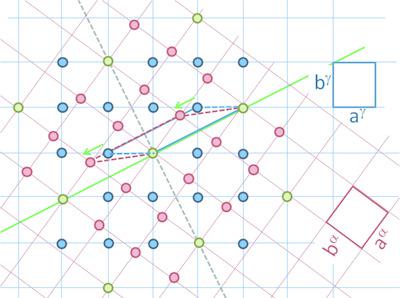当前位置:
X-MOL 学术
›
Acta Crystallogr. A Found. Adv.
›
论文详情
Our official English website, www.x-mol.net, welcomes your
feedback! (Note: you will need to create a separate account there.)
The transformation matrices (distortion, orientation, correspondence), their continuous forms and their variants
Acta Crystallographica Section A: Foundations and Advances ( IF 1.9 ) Pub Date : 2019-04-10 , DOI: 10.1107/s205327331900038x Cyril Cayron 1
Acta Crystallographica Section A: Foundations and Advances ( IF 1.9 ) Pub Date : 2019-04-10 , DOI: 10.1107/s205327331900038x Cyril Cayron 1
Affiliation

|
The crystallography of displacive/martensitic phase transformations can be described with three types of matrix: the lattice distortion matrix, the orientation relationship matrix and the correspondence matrix. Given here are some formulae to express them in crystallographic, orthonormal and reciprocal bases, and an explanation is offered of how to deduce the matrices of inverse transformation. In the case of the hard-sphere assumption, a continuous form of distortion matrix can be determined, and its derivative is identified to the velocity gradient used in continuum mechanics. The distortion, orientation and correspondence variants are determined by coset decomposition with intersection groups that depend on the point groups of the phases and on the type of transformation matrix. The stretch variants required in the phenomenological theory of martensitic transformation should be distinguished from the correspondence variants. The orientation and correspondence variants are also different; they are defined from the geometric symmetries and algebraic symmetries, respectively. The concept of orientation (ir)reversibility during thermal cycling is briefly and partially treated by generalizing the orientation variants with n -cosets and graphs. Some simple examples are given to show that there is no general relation between the numbers of distortion, orientation and correspondence variants, and to illustrate the concept of orientation variants formed by thermal cycling.
中文翻译:

变换矩阵(扭曲、方向、对应)、它们的连续形式及其变体
位移/马氏体相变的晶体学可以用三种类型的矩阵来描述:晶格畸变矩阵、取向关系矩阵和对应矩阵。这里给出了一些用晶体学、正交基和倒数基来表达它们的公式,并解释了如何推导逆变换矩阵。在硬球假设的情况下,可以确定畸变矩阵的连续形式,并将其导数识别为连续介质力学中使用的速度梯度。畸变、方向和对应变体是通过具有交集的陪集分解来确定的,交集取决于相位的点组和变换矩阵的类型。马氏体相变现象学理论中所需的拉伸变体应与对应变体区分开来。方向和对应变体也不同;它们分别由几何对称性和代数对称性定义。热循环过程中取向(ir)可逆性的概念通过概括取向变体进行了简要和部分的处理n -陪集和图表。给出了一些简单的例子来说明变形数量、取向和对应变体之间不存在一般关系,并说明了热循环形成的取向变体的概念。
更新日期:2019-04-10
中文翻译:

变换矩阵(扭曲、方向、对应)、它们的连续形式及其变体
位移/马氏体相变的晶体学可以用三种类型的矩阵来描述:晶格畸变矩阵、取向关系矩阵和对应矩阵。这里给出了一些用晶体学、正交基和倒数基来表达它们的公式,并解释了如何推导逆变换矩阵。在硬球假设的情况下,可以确定畸变矩阵的连续形式,并将其导数识别为连续介质力学中使用的速度梯度。畸变、方向和对应变体是通过具有交集的陪集分解来确定的,交集取决于相位的点组和变换矩阵的类型。马氏体相变现象学理论中所需的拉伸变体应与对应变体区分开来。方向和对应变体也不同;它们分别由几何对称性和代数对称性定义。热循环过程中取向(ir)可逆性的概念通过概括取向变体进行了简要和部分的处理











































 京公网安备 11010802027423号
京公网安备 11010802027423号